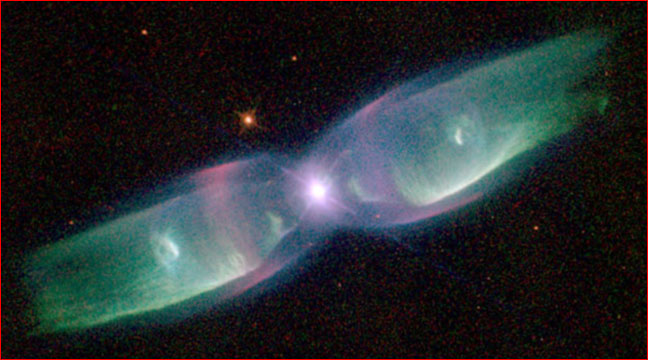|
|
||
 Credit: B. Balick (U. Washington) et al., WFPC2, HST, NASA |
||
|
pic of the day Links:
Society for
|
Dec 24, 2004 In the electric universe cosmology, explosions, dying stars, and collision are replaced by plasma phenomena for the production of such beautiful and intricate structures. The following description of the Butterfly Nebula appears on the Astronomy Picture of the Day (APOD) for Feb. 1, 2004:. "Are stars better appreciated for their art after they die? Actually, stars usually create their most artistic displays as they die. In the case of low-mass stars like our Sun and M2-9 pictured above, the stars transform themselves from normal stars to white dwarfs by casting off their outer gaseous envelopes. The expended gas frequently forms an impressive display called a planetary nebula that fades gradually over thousand of years...Much remains unknown about the physical processes that cause planetary nebulae." See M2-9: Wings of a Butterfly Nebula The electric universe or plasma cosmology explanation is different. This nebular formation seen here, one of the most beautiful and distinctive, seems to be a variation on the ubiquitous "hourglass" or "butterfly" shaped glow-discharge structure observed in other nebulas. Sometimes this funnel-shaped formation is seen as a ring or offset oval rings when viewed "up the barrel". It is not in space alone that we observe the unique components of plasma discharge discussed here. The same formations can be seen in the laboratory, though most astronomers remain unaware that electrified plasma generates these observed forms. The "hourglass" discharge configuration, which may have nested hourglasses as viewed here, is forcing a reconsideration of the physics of nebular formation. According to Raghavendra Sahai, an astronomer at JPL in Pasadena, California, "What we thought we understood of planetary nebulae we no longer do. Something different and dramatic is going on." As to the dramatic shape and structure, especially the nested hourglass; this should all be a deal-killer for explosion-type theories, Sahai states, "It is very hard to see how you get it." But the embedding of similar configurations is not a surprise to experts on plasma discharge. See also Archive July 7, 2004 The Bug Nebula Composed by Michael Armstrong |
|
|
Copyright 2004: thunderbolts.info |
||
